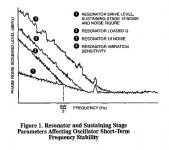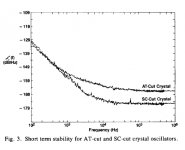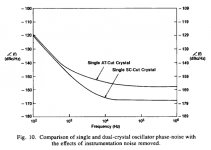Do you test anytime the Clapp oscill. (TWTMC-C) in this audio chain, if not, will you?
I saw the PN of Driscoll AT-cut measurement wasnt so good like Clapp (see Rutgers measurement). Driscoll with SC cut xtal will it improve enough to overtake the Clapp type boards?
The measured Driscoll oscillator is a 22.5792 Mhz using a cheap HC-49/U AT-Cut crystal, while the measured Clapp is a 11.2896 MHz using a polished and selected crystal.
There was a big sonic improvement using the Laptech AT-Cut in HC-43/U package, I also expect more improvement using SC-Cut crystal, due to its high Q, since the Driscoll oscillator maximizes the loaded Q.
As soon as I will find the time I will do a full comparison of all the circuits/crystals presented in this thread.
"legendary 723."
what's that? could you please be more specific?
It was a Voltage Regulator driver designed in the late 60's (I think).
It is a linear controller, but has circuit features that lend itself to very low noise design.
If you talk to some of the old timers, you'll hear they built some really low noise
PSU's with them. it was a wonderful component.
Last edited:
> At lower f even SC-cut xtals operate at fundamental-mode.
No. The whole point is maximizing the active quartz volume.
I have an overtone osc at 3 MHz made by Ovenaire, 4 example.
> For each additional overtone mode, the ESR increases.
And that is a good thing. Since if a crystal achieves its high Q
in spite of a high R0, this will result in much less loss of
operating Q when it is is series to one or two emitter ports
as in Driscoll or Butler.
The emitter impedance depends on gm, and you cannot increase
the standing current without limit. Emitter impedance goes from
a few Ohms for a BJT to maybe 50 Ohms for a lazy FET.
With 50 Ohms in series to a crystal with R0=50 you have
halved operating Q right from the start.
regards, Gerhard
no time for more comments now.
No. The whole point is maximizing the active quartz volume.
I have an overtone osc at 3 MHz made by Ovenaire, 4 example.
> For each additional overtone mode, the ESR increases.
And that is a good thing. Since if a crystal achieves its high Q
in spite of a high R0, this will result in much less loss of
operating Q when it is is series to one or two emitter ports
as in Driscoll or Butler.
The emitter impedance depends on gm, and you cannot increase
the standing current without limit. Emitter impedance goes from
a few Ohms for a BJT to maybe 50 Ohms for a lazy FET.
With 50 Ohms in series to a crystal with R0=50 you have
halved operating Q right from the start.
regards, Gerhard
no time for more comments now.
Last edited:
I am very pleased to see that this thread that started out as an attempt to build a low cost and high quality Xtal oscillator, developed into an almost scientific discussion on how to achieve the ultimate performance at reasonable cost.
The down side for me is I do not know enough about the subject to contribute.... but it's very educational!
The down side for me is I do not know enough about the subject to contribute.... but it's very educational!
> At lower f even SC-cut xtals operate at fundamental-mode.
No. The whole point is maximizing the active quartz volume.
I have an overtone osc at 3 MHz made by Ovenaire, 4 example.
> For each additional overtone mode, the ESR increases.
And that is a good thing. Since if a crystal achieves its high Q
in spite of a high R0, this will result in much less loss of
operating Q when it is is series to one or two emitter ports
as in Driscoll or Butler.
The emitter impedance depends on gm, and you cannot increase
the standing current without limit. Emitter impedance goes from
a few Ohms for a BJT to maybe 50 Ohms for a lazy FET.
regards, Gerhard
no time for more comments now.
That's what I said several times on this thread.
IMHO, the goal is to select crystals with higher Q as possible to use them in oscillators that maximize the loaded Q such as the Driscoll and the Butler.
In the Leeson model the close in phase noise is dtermined mainly by the crystal Q.
The best way to get the highest crystal Q is to select harmonic SC-Cut crystals (3rd or better 5th overtone).
Testing clock osillators by listening to them is the wrong way! Just MEASURE the fase noise close to the carrier. That goes best with a DC receiver like Wenzel does. Also read: https://www.by-rutgers.nl/PDFiles/DC-receiver.pdf
Herbert.
Herbert.
...to use oscillators that maximize the loaded Q such as the Driscoll and the Butler.
In the Leeson model the close in phase noise is determined mainly by the crystal Q.
Absolutely correct, theoretically.
But there are more parameters affecting the close-in PN.
What Im saying is that the optimal close-in PN might be easier to achieve with an AT-cut.
Attachments
Last edited:
I dont understand what you mean by quartz volume here.No. The whole point is maximizing the active quartz volume.
I have an overtone osc at 3 MHz made by Ovenaire, 4 example.
If a crystal achieves its high Q
in spite of a high R0, this will result in much less loss of
operating Q when it is is series to one or two emitter ports
as in Driscoll or Butler.
This is correct.
Last edited:
When I'm onest I do not realy know which parameter of the Xtal is most significant, but I can MEASURE my oscillators directly, so I'm not interested ín all the theory. That is nice to find the direction where to go but eventualy you should MEASURE things.
I make the statement again: My oscillator is REPRODUCIBLE !!! The only question left is wich Xtal to use.... and there are dammed good Xtals!
Herbert.
I make the statement again: My oscillator is REPRODUCIBLE !!! The only question left is wich Xtal to use.... and there are dammed good Xtals!
Herbert.
can we draw any information about close in noise from ADEV measurements? I would think that there would be a good correlation but maybe i'm missing something. I would prefer than since I'm setup for ADEV.
Hmmm, interesting thought.
I think this would be very possible. It is logical to assume that close-in PN might be visible in the lower tau-regions of the graph.
The lowest corresponding ADEV (y-axis) figures would then indicate best ST-stability.
cheers
Last edited:
That's what I said several times on this thread.
The best way to get the highest crystal Q is to select harmonic SC-Cut crystals (3rd or better 5th overtone).
Theoretically yes.
Remember, it's not a trivial task to extract a 5th overtone excitation properly.
Close-in PN is affected by many parameters.
These can be optimized to achieve a comparable result to the really expensive SC-cut ocxo's (as done in the RutgerS).
cheers
Attachments
Last edited:
The diagram says all! Close in noise is at ditances from the carrier below ~50 Hz....
Herbert.
What I'm saying is that in theory (for ex Leeson equation) it would be possible to achieve
lower close-in PN figures with SC cut crystals.
That is, any generated noise in the output signal being more
effectively surpressed by the higher Q of the xtal (clearly visible by lower floor for SC) - all other parameters being normalized and equal.
But they might not necessarily be the case in practice.
With good equipment + knowledge + and lots of time, I am positive it is possible to achieve
lower close-in PN with SC-cut xtals, but not by as much as we think.
Last edited:
The diagram says all! Close in noise is at ditances from the carrier below ~50 Hz....
Herbert.
?? The plots stop at 100 Hz. its not clear what happens below 100 Hz from the plots even though they seem to converge.
Phase noise is short term variations in frequency. 'Close in " phase noise really is longer term variations in frequency. The region in question here seems to be in the 1 second to 100 Hz range, which is also the most difficult to measure.
http://tycho.usno.navy.mil/ptti/2004papers/paper14.pdf
And still finding a way to genuinely attribute sonic benefits in blind testing is needed. The current lit indicates that the audibility threshold is way higher than any of this stuff, whether for wow and flutter or for jitter.
Part of the challenge is confirming that the sonic difference is from the phase noise and not some other incidental change that could be significant.
I posted here the effects of jitter in an oscillator and a simple mitigation: http://www.diyaudio.com/forums/equi...zer-ak5397-ak5394a-ak4490-58.html#post4820974 The clear impact of the jitter/modulation on the signal is obvious and the mitigation altered none of the clock circuitry itself. These are the type of incedental changes i'm talking about. They may only be seen in the analog output, which is where it ultimately matters.
With good equipment + knowledge + and lots of time, I am positive it is possible to achieve
lower close-in PN with SC-cut xtals, but not by as much as we think.
The early BVA oscillators from Oscilloquarz were AT cut. The later ones were SC. I don't know if there are comparable numbers available. The BVA does have the highest stability of any commercial oscillator BVA 8607: 10 times more stable than any other OCXO but not as good overall phase noise as the Wenzel blue top BTULN |
To put this in perspective, the BVA is discontinued, it was around $5000 ea + a 1 year lead time. The The Blue top is around $1500 and a 3 month or so lead time. The Blue top is also a controlled "munition" and can't be exported with out federal approval. I asked. . .
Testing clock osillators by listening to them is the wrong way! Just MEASURE the fase noise close to the carrier. That goes best with a DC receiver like Wenzel does. Also read: https://www.by-rutgers.nl/PDFiles/DC-receiver.pdf
Herbert.
True and not true....
True: as I said I don't like to publish listening impressions since they are subjective.
Not true: that's the reason I invite everyone to do their listening session comparing the oscillators. At the end we would build good devices to listen to music. But we are diyers and we cannot afford an Agilent E5052, so the ears are the best judge.
What I'm saying is that in theory (for ex Leeson equation) it would be possible to achieve
lower close-in PN figures with SC cut crystals.
That is, any generated noise in the output signal being more
effectively surpressed by the higher Q of the xtal (clearly visible by lower floor for SC) - all other parameters being normalized and equal.
But they might not necessarily be the case in practice.
With good equipment + knowledge + and lots of time, I am positive it is possible to achieve
lower close-in PN with SC-cut xtals, but not by as much as we think.
Please, take a look at this document: http://scholar.sun.ac.za/bitstream/...investigation_2007.pdf?sequence=1&isAllowed=y
-140dBc at 10Hz from the carrier was achieved with an SC-Cut crystal and a Driscoll oscillator. Maybe better, since the noise floor of the Aeroflex is higher than the DUT.
I'm not sure that such performance could be reached with AT-Cut crystals.
I looked at the specs... they seem impressive to me, but I don't see a $1500,- clock in a DAC... Besides, the long-term stability seems to me not very relevant to Audio. On the other hand the Close in Noise does..The early BVA oscillators from Oscilloquarz were AT cut. The later ones were SC. I don't know if there are comparable numbers available. The BVA does have the highest stability of any commercial oscillator BVA 8607: 10 times more stable than any other OCXO but not as good overall phase noise as the Wenzel blue top BTULN |
To put this in perspective, the BVA is discontinued, it was around $5000 ea + a 1 year lead time. The The Blue top is around $1500 and a 3 month or so lead time. The Blue top is also a controlled "munition" and can't be exported with out federal approval. I asked. . .
So I could understand some effort to further improve the Close in Noise, if not at too high a cost. Which measures could lead to that improvement?
Testing clock osillators by listening to them is the wrong way! Just MEASURE the fase noise close to the carrier. That goes best with a DC receiver like Wenzel does. Also read: https://www.by-rutgers.nl/PDFiles/DC-receiver.pdf
Herbert.
Of course. On the other hand it would to get an idea of what the limits are if close-in phase noise audibility -- for example at 1hz: is it -100dB/hz or -130 dB/hz?
- Status
- Not open for further replies.
- Home
- Source & Line
- Digital Line Level
- The Well Tempered Master Clock - Building a low phase noise/jitter crystal oscillator


